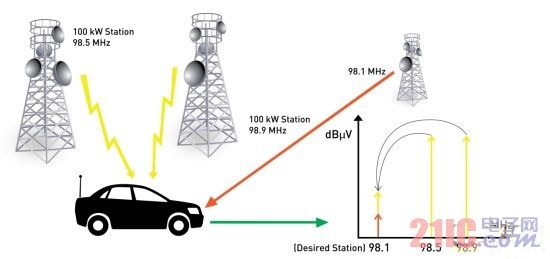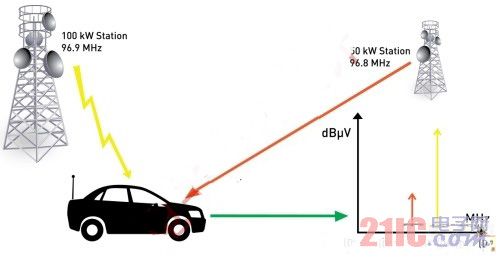High-growth economies such as Brazil, Indonesia, India and China have emerged as emerging middle classes and fast-growing auto markets. These markets require relatively low retail prices for automobiles, which puts significant cost pressure on automotive components. In addition, in the automotive markets of developed economies such as the United States, European countries and Japan, demand for cost-sensitive solutions has increased since the global financial crisis of 2008, and since almost all cars, trucks and trucks are equipped AM/FM radios, radio module manufacturers are actively looking for solutions that reduce costs and meet traditional automotive-grade performance requirements.
This article refers to the address: http://
The conventional AM/FM tuner used in automobiles is mainly a BiCMOS tuner of a 10.7 MHz IF tuner architecture. This technology/architecture enables radio reception performance at an extremely high cost: the technology combines front-end RF circuitry with back-end digital processing engines (such as DSPs and MCUs) to perform audio processing and output in a single-chip circuit. And the cost of the architecture is prohibitive.
Digital low-IF CMOS AM/FM receivers meet cost and performance requirements due to very low CMOS manufacturing costs and the use of digital low-IF architectures. Digital low-IF AM/FM receivers have been in use for several years in the mobile phone and portable media player markets. Power consumption and cost are critical factors in this type of market, and in the automotive market, mobile reception and higher performance expectations make the tuner meet higher performance requirements.
Let's discuss a few key requirements for an AM/FM broadcast receiver optimized for automotive applications.
RF dynamic range
The crowded FM spectrum in the city is very common. A large number of radio stations can cover the weaker radio signals received by the radio. As shown in Figure 1, the most severe and most common nonlinear distortion caused by strong interfering signals is three. Order Intermodulation Distortion (IMD3), which is caused by the superposition of two adjacent strong interfering signals on the weak signal channel.
In many applications, an external tracking filter is used at the front end of the receiver to attenuate interfering signals. However, this technique is very expensive in terms of device and PCB cost. In the crowded FM spectrum, the interfering signal is too close to the weak signal of the intended station and difficult to filter. In order to minimize IMD3 distortion products, there must be a suitable receiver front-end dynamic range. Low dynamic range tuners require expensive high Q tracking filters to avoid IMD3 (he can give listeners a poor listening experience). High linear receivers typically exceeding 75dB dynamic range are suitable for most receiving environmental conditions, but given the cost constraints, receivers with built-in dynamic range and no external tracking filters are more worth considering because they maintain performance while still maintaining performance. Can reduce system costs.

Figure 1 RF dynamic range protection
Selective and dynamic bandwidth control
Selectivity means that the tuner can receive the weak radio signal with strong radio signal interference with minimal deviation (see Figure 2). This is very important for the crowded FM spectrum in urban environments. Adjacent channel selectivity is an important performance requirement (especially for the European market where the FM broadcast channel spacing is 100 kHz). It refers to the ability to suppress signals outside the ±100 kHz frequency range. In many low-cost types of tuners, This usually does not exceed 30dB.
Although the 30dB selection performance can satisfy most listening environments, there are actually many cases where the listener listens to a radio signal from a distant tower when there are multiple stations in the local area, and such scenes need a higher choice. Sex. Many radio receiver solutions are implemented through a high dynamic range and a flexible dynamic channel bandwidth control engine that can suppress adjacent channels. Using digital low-IF integrated receivers, dynamic channel bandwidth control is implemented using powerful advanced radio DSP logic that optimizes the channel bandwidth for strong interfering signals by measuring adjacent and alternate channel environments.

Figure 2 FM dynamic channel selectivity
Sensitivity
Sensitivity is the ability of a tuner to receive weak radio signals. If you live in a rural area, away from the transmitters of most radio stations, the sensitivity of the tuner is very important. Today's car radios typically achieve microvolt-level sensitivity, allowing car radios to receive particularly weak radio signals and tune out radio signals that are tens of miles away. Cost pressures need to support this sensitivity level and eliminate the need for a low noise amplifier (LNA) receiver, which sets a very high standard for integrated CMOS receivers that require an RF front end and high speed integrated on the same wafer IC Digital processing engine to achieve.
Alternate frequency (AF) check
In Europe, the alternate frequency (AF) technique (shown in Figure 3) is an excellent choice. It allows the car radio tuner to tune to a different frequency that provides the same radio content when the preferred signal is too weak and out of range. . This technique is commonly used in European car radio systems, using Radio Data System (RDS) technology to transmit AF lists via RDS data.
In premium cars, a dedicated companion tuner is used to scan the AF list and provide AF station parameters to the radio to determine when to jump to the AF station when the primary station's reception performance drops. It is too expensive to use two tuners in a cost-sensitive radio. The main audio tuner can be tuned to the AF station for signal measurement and then returned to the preferred station without causing an audio interruption. The maximum time to perform an AF check is no more than 10ms, and exceeding this time will result in an audible interruption of the audio.
The AF switching strategy depends on several signal quality indicators, including Received Signal Strength Indication (RSSI) and Signal to Noise Ratio (SNR). The advantage of using an integrated digital receiver is that it can perform two operations using a high-speed digital signal processing engine: 1) RDS demodulation and decoding to provide a list of AF stations; 2) rapid completion of signal quality indicator evaluation calculations to meet fast AF inspection time Claim.

Figure 3 Alternate station evaluation check
In summary, the ongoing cost pressures of the global automotive market are driving the development and deployment of highly integrated and innovative CMOS radio IC solutions that will significantly reduce costs, replacing automotive radio tuners with traditional architecture and simulation. Semiconductor processing process solutions.
LED Wall Wash Light
Wall Wash Light Series Include 36x12w LED Wash light, 19x15w Led wash light; Both is hot selling in the lighting market.
36X12W RGBW 4 IN 1/5 IN 1/6 IN 1 /LED Wash Moving Head Light
Specification:
Pure bright in color effect, excellent color mixing, good heat cooling
36 pcs 12W RGBWA+UV 6in1 LED, 36 pcs 10W RGBWA 5in1 LED, 36 pcs 10W RGBW 4in1 LED
10-60 zoom angle, narrow beam effect to wide wash effect, functional in usage.
Small size, easy to carry and install, each unit weighs only 9kg
Linear smooth dimmer from 0-100%, 1-20 times strobe per second, flicker-free for TV and films.
Suitable for mobile productions, events, parties, stage installations, theater, musical concert, TV studios.
Our company have 13 years experience of LED Display and Stage Lights , our company mainly produce Indoor Rental LED Display, Outdoor Rental LED Display, Transparent LED Display,Indoor Fixed Indoor LED Display, Outdoor Fixed LED Display, Poster LED Display , Dance LED Display ... In additional, we also produce stage lights, such as beam lights Series, moving head lights Series, LED Par Light Series and son on...
Wall Wash Light Series,Disco Light,Led Washer Light,Moving Head
Guangzhou Chengwen Photoelectric Technology co.,ltd , https://www.cwstagelight.com
